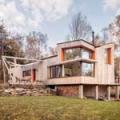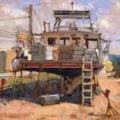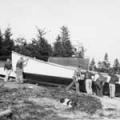Björn Runquist
The Business of Paying Attention
All photos courtesy the artist unless otherwise noted
 The artist plein air painting in Camden, July 2024. Photo by Colin Page
The artist plein air painting in Camden, July 2024. Photo by Colin Page
Clark Island in the town of Saint George, artist Björn Runquist explains, “is the lovely remains of a stone cutters’ village that once had a school, a store, a union hall, etc.” In 1900, this hamlet and the island across the granite causeway for which it is named featured full-scale working granite quarries. With the development of steel and concrete, they eventually shut down.
Today, the town provides a home base from which Runquist makes forays to various spots along the mid-Maine coast. He is a year-round plein air painter, out in the elements with his easel, shifting his palette season to season, finding light and energy in every landscape he encounters.
Runquist often paints waterfront scenes, with nearby Rockland a major source of subjects. The painting Ice finds him on the wharf by the harbormaster’s shed. Bathed in late summer light, the ice machine and small building work as formal elements and also evoke, writes the artist, “the excitement of approaching one’s boat…and preparing for an outing.”
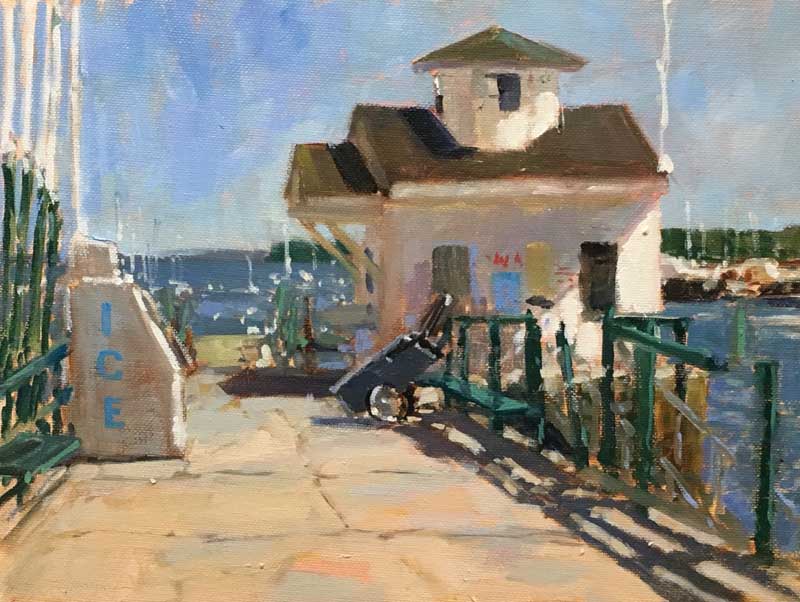 Björn Runquist is drawn to the authenticity of Maine’s working waterfront. Ice, 2019, oil on linen, 12 by 16 inches.
Björn Runquist is drawn to the authenticity of Maine’s working waterfront. Ice, 2019, oil on linen, 12 by 16 inches.
The painter also loves the sense of history that goes with seafaring Maine. “Schooners are a perfect blend of form and function,” he writes, “and they’re beautiful.” At the same time, he is not into painting the nostalgia of a disappearing Maine: “Life is here and now,” he avers. The working waterfront embodies that: “It is not picturesque or romantic but very real.”
On several occasions Runquist has painted the seaweed processing plant on Rockland Harbor between the Maine State Ferry Service landing and the Coast Guard station. In Evening at Lermond Cove the building complex is a study in white, lit by late sunlight, rising out of still waters into a cloud-brushed sky.
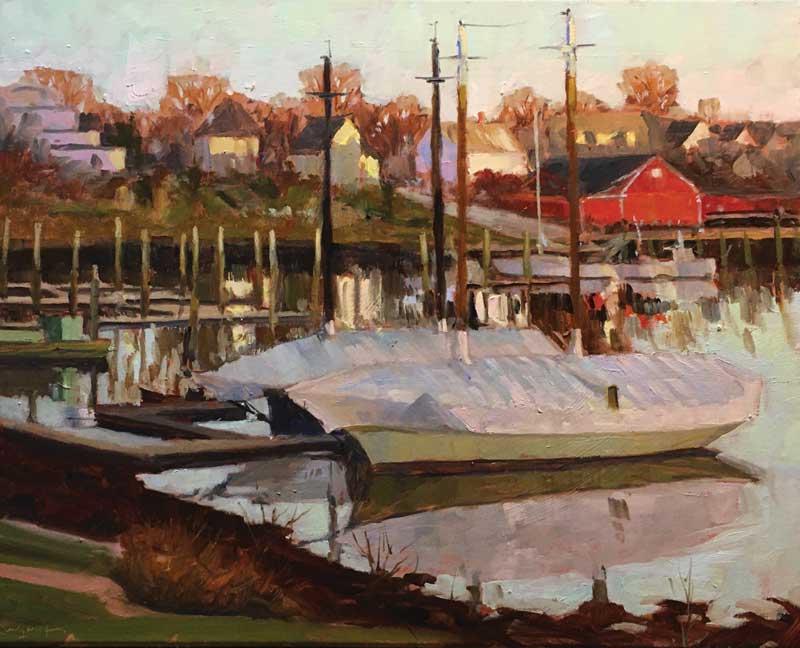 Runquist captures the end of the sailing season in this harbor scene. November, Camden Calm, 2018, oil on linen, 16 x 20 inches.
Runquist captures the end of the sailing season in this harbor scene. November, Camden Calm, 2018, oil on linen, 16 x 20 inches.
Runquist relishes the seasonal changes that lead to shifts in palette. His painting of two wrapped sailboats, November, Camden Calm, evokes that time when fall approaches winter and darkness starts to reign. The tops of the masts of the shrouded vessels catch the last daylight.
Runquist notes that he is typically drawn to scenes that are not, in and of themselves, exceptional. Indeed, he seeks to find the miraculous “within the ordinary.” He is a firm believer that there is “something worth painting—noticing—in front of you all the time,” adding, “You just have to pay attention.” That’s what his paintings are all about, “the business of paying attention.”
A perfect example of this approach to the world: a series of views of Wheeler Bay called Aubades: Greetings to the Morning, painted in 2014. Runquist painted the same vista on a 4-by-8-inch panel each morning between 6:00 and 7:30 a.m.
Runquist has also painted Hall’s Market, now known as the Tenants Harbor General Store, on several occasions. “When Linda Bean bought it,” he recalls, “she put the flag up,” which added “some great color.” So he was drawn to paint it again.
 In Runquist’s hands, a seaweed processing plant becomes a study in light. Evening at Lermond Cove, Rockland, 2019, oil on linen, 20 x 30 inches.
In Runquist’s hands, a seaweed processing plant becomes a study in light. Evening at Lermond Cove, Rockland, 2019, oil on linen, 20 x 30 inches.
Born in Sweden in 1948, Runquist spent his early life moving around. When he was 4, his family emigrated to the U.S., where he grew up in Croton-on-Hudson, 40 or so miles north of New York City. Just as he turned 15, his father, Lars Runquist, a chemical engineer working for Bechtel, was transferred to Le Havre in Normandy to modernize an oil refinery. The family stayed in France for nearly three years. Runquist attended a French high school—“a challenging experience,” he recalls.
Upon returning stateside, Runquist finished high school and enrolled at Colgate University in Hamilton, New York. He spent his junior year in Dijon, France, where he met “a lovely Norwegian” named Anne-Cecilie Bruland who became his wife in 1972. Following graduation, they moved to London for four years. Runquist earned a masters in romance languages and literature at King’s College and taught English as a foreign language.
In 1976, he and his wife moved back across the pond, settling in Connecticut. His knowledge of French proved valuable; he taught in the modern languages department at Kent and Choate-Rosemary Hall boarding schools for more than 30 years.
Runquist’s life in art started at age 7 while living in Croton-on-Hudson. He won a local newspaper-sponsored coloring contest, which led his parents—“bless their hearts”—to arrange for lessons with a local artist, Nils Strom, who also happened to be Swedish. Runquist met with him every Saturday until he was 10.
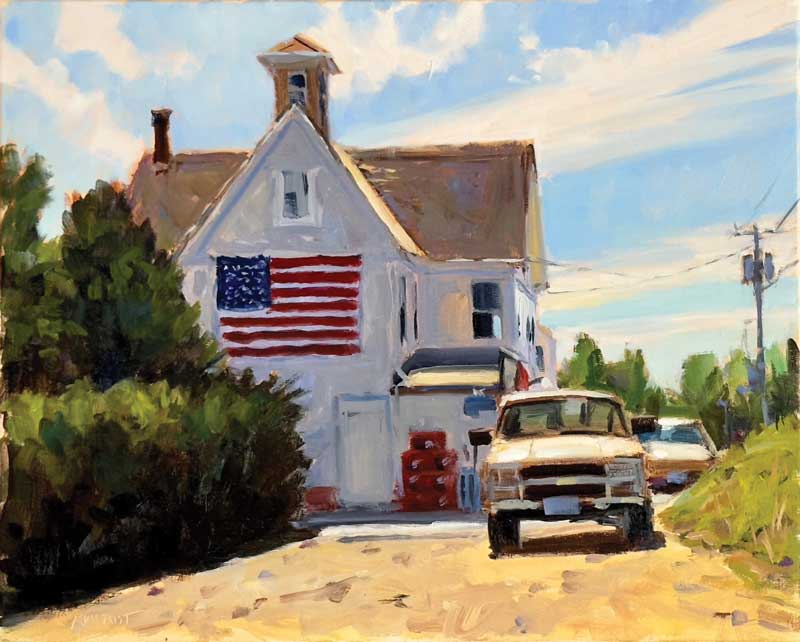 A local landmark in Tenants Harbor caught Runquist’s eye. Hall’s Market, 2014, oil on linen, 16 x 20 inches. Photo by Ni Rong
A local landmark in Tenants Harbor caught Runquist’s eye. Hall’s Market, 2014, oil on linen, 16 x 20 inches. Photo by Ni Rong
Strom (1903-1971) was, in Runquist’s words, “a classic eccentric artist” (for the 1950s United States, he says), who lived in a small rambling house he had built with his own hands on top of a mountain. “He had a big beard, smoked a pipe, chewed raw garlic, and drove a jeep with no doors,” his pupil recalls—and had geese, goats, and a donkey.
Teacher and student worked in all media, including paint, clay, and real frescoes on the walls of Strom’s unfinished house. They would also play chess and study art books—Picasso, Goya, et al. They drew each other and went on sketching expeditions. “I don’t remember any particular thing I learned with him,” Runquist notes, “other than a certain attitude towards creativity and education.”
In high school, Runquist became “more or less” one of the “art kids,” he said. At Colgate he started out as an art major but, dissatisfied with his first studio painting class, switched to anthropology and then French.
All the while Runquist continued to paint. He considers himself essentially self-taught but credits a variety of sources and mentors for his growth as an artist. One book in particular, David Friend’s The Creative Way to Paint, first published in 1966, completely changed his understanding of painting.
The gift of a box of soft pastels led Runquist to explore non-figurative work. He immersed himself in the study of the Abstract Expressionists and modern art. These deep dives inspired a return to imagery related to “dreams and memories (a fascination with Carl Jung and mythology).” Over time he explored other mediums, including oil pastel, acrylic, watercolor, and oil.
When Runquist was young, for several summers his parents rented a cottage on Cliff Island, “the last island out in Casco Bay.” Those sojourns laid the foundation for his conception of paradise—and drew him back to Maine years later to search for a place he could call his own. Since retiring from teaching in 2013, he has been a full-time resident of the aforementioned Clark Island.
Spending more time on the Maine coast, Runquist felt a longing to paint, again, what lay in front of him. “I think I was moved first by Maine artists such as Milton Avery, then Marsden Hartley, and finally Fairfield Porter (as the ultimate example of painting the essential here and now).” John Singer Sargent’s work compelled him to paint more realistically—“rather a backwards journey,” he writes, “but it all has its place.”
Runquist’s son, Tollef, has followed in his father’s footsteps, establishing himself as a well-known Maine painter (see MBH&H, April/May 2015). “I did not teach Tollef in any real way,” Runquist admits, “he was much too independent a child to take any direct teaching from me.” A few years ago, his son told him that when he was little and his father was in the middle of his “abstract” period, he would come into his studio and look around. “None of what he saw made sense to him but he had a clear feeling that something very special was going on,” Runquist recounts. “I like that.” The two are very close and frequently talk about each other’s work and have taught workshops together.
Runquist has been generous with his art, supporting Trekkers, Habitat for Humanity of Waldo County, the Camden Library, Cape Elizabeth Land Trust, and other nonprofits. His paintings have earned him a place in the pantheon of contemporary Maine artists devoted to representing the land and sea in all their diverse glory—and there’s an appreciative audience of collectors and art lovers to go with that stature. The “business of paying attention” has paid off.
✮
Carl Little’s latest book is Art of Penobscot Bay, co-authored with his brother, David. He lives and writes on Mount Desert Island.
More of Runquist’s works can be viewed at www.bjornrunquist.com. He is represented by the Landing Gallery in Rockland and has an annual summer show at the Granite Gallery in Tenants Harbor.
Related Articles
Share this article:
2023 Maine Boat & Home Show

Join Us for the Maine Boat & Home Show!
Art, Artisans, Food, Fun & Boats, Boats, Boats
August 11 - 13, 2023 | On the waterfront, Rockland, Maine
Click here to pre-order your tickets.
Show is produced by Maine Boats, Homes & Harbors magazine.










